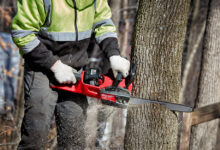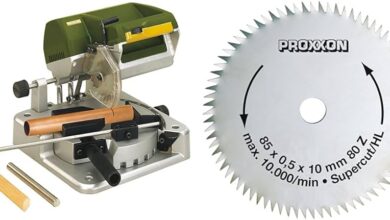Contents
- 1 Preamble
- 2 Essential Chainsaw Blade Maintenance Tips
- 2.1 Sharpening: The Cornerstone of Efficient Cutting
- 2.2 Frequency of Sharpening: Striking the Right Balance
- 2.3 Lubrication: Preserving Blade Life and Performance
- 2.4 Appropriate Oil Type: Choosing the Right Formula
- 2.5 Self-Lubricating Chains: A Convenient Alternative
- 2.6 Proper Tensioning: Striking the Delicate Balance
- 2.7 tension Adjustment Procedure: A Step-by-Step Guide
- 2.8 Cleaning: Removing Dirt and Debris for Optimal Performance
- 2.9 Cleaning Methods: Choosing the Appropriate Approach
- 2.10 Storage: Protecting the Blade During Downtime
Preamble
The chainsaw, an indispensable tool for forestry, landscaping, and home improvement projects, relies heavily on its sharp, precise blade for efficient and safe operation. Maintaining the blade is paramount to maximizing the chainsaw’s performance, extending its lifespan, and minimizing the risk of accidents. This comprehensive guide delves into practical tips for chainsaw blade maintenance, empowering users to ensure their equipment remains in optimal condition.
Introduction
Chainsaw blades are subjected to extreme forces during use, encountering abrasive wood fibers, dirt, and debris. Consequently, proper maintenance is essential to maintain their sharpness and prevent premature wear. Neglecting blade maintenance not only impairs cutting efficiency but also increases the likelihood of kickback, a dangerous situation where the chainsaw abruptly recoils towards the operator. By adhering to regular maintenance practices, users can prolong the blade’s lifespan, reduce operating costs, and enhance overall safety.
Recognizing the significance of chainsaw blade maintenance, this article provides a comprehensive overview of essential maintenance tips. From sharpening to lubrication, tensioning to storage, every aspect of blade care is covered in detail. By following these guidelines, users can ensure their chainsaw remains a reliable and effective tool for years to come.
Essential Chainsaw Blade Maintenance Tips
Sharpening: The Cornerstone of Efficient Cutting
Sharpening the chainsaw blade is crucial for maintaining optimal cutting performance. A sharp blade effortlessly slices through wood, requiring less force from the operator and reducing the risk of kickback. Conversely, a dull blade struggles to penetrate wood, increasing the likelihood of binding and jamming, which can lead to accidents. Hence, regular sharpening is indispensable for maximizing chainsaw efficiency and safety.
Frequency of Sharpening: Striking the Right Balance
The optimal frequency of sharpening depends on the intensity and duration of chainsaw use. For occasional users, sharpening every 3-4 uses may suffice. However, frequent and heavy users should sharpen their blades more often, perhaps every 1-2 uses. Monitoring the blade’s sharpness is key, and users should sharpen it as soon as they notice reduced cutting efficiency or increased operating effort.
Lubrication: Preserving Blade Life and Performance
Lubrication plays a vital role in extending chainsaw blade life and maintaining its optimum performance. Purpose-made chainsaw oil reduces friction between the blade’s moving parts, preventing premature wear and tear. Additionally, lubrication prevents the blade from overheating, which can lead to warping and reduced cutting efficiency.
Appropriate Oil Type: Choosing the Right Formula
Selecting the appropriate chainsaw oil is crucial for effective lubrication. Manufacturers typically recommend specific oil formulations that are compatible with their chainsaws. These oils are designed to adhere to the blade and resist being flung off during operation, ensuring continuous lubrication. Using inappropriate oils can damage the blade, reduce its lifespan, and impair cutting performance.
Self-Lubricating Chains: A Convenient Alternative
Self-lubricating chains are a convenient option for users who prefer reduced maintenance. These chains feature built-in oil reservoirs that automatically lubricate the blade as it rotates. While they eliminate the need for manual lubrication, self-lubricating chains may not provide the same level of lubrication as traditional methods. Users should carefully consider their operating requirements and budget when deciding between self-lubricating and manually lubricated chains.
Proper Tensioning: Striking the Delicate Balance
Maintaining proper chain tension is essential for safe and efficient chainsaw operation. A properly tensioned chain reduces the likelihood of derailment and kickback while enabling the blade to rotate smoothly. Conversely, an overly loose chain can come off during use, posing a safety hazard, while an overly tight chain increases friction and wear on the blade and sprocket.
tension Adjustment Procedure: A Step-by-Step Guide
Adjusting chain tension is a straightforward procedure that can be performed using a simple wrench. Begin by loosening the chain tensioning screw on the chainsaw’s body. Next, pull the guide bar forward slightly to tighten the chain. It should be snug but not overly tight. Aim for a tension where the chain does not sag when lightly pulled but also moves freely around the guide bar.
Cleaning: Removing Dirt and Debris for Optimal Performance
Cleaning the chainsaw blade regularly is essential for removing dirt, sawdust, and debris that can accumulate during use. These contaminants can clog the blade’s grooves, reducing its cutting efficiency and increasing friction. Cleaning the blade extends its lifespan and ensures it continues to operate at peak performance.
Cleaning Methods: Choosing the Appropriate Approach
Various cleaning methods can be used to remove dirt and debris from the chainsaw blade. Using a cloth or brush to gently wipe away loose particles is a simple and effective approach. For more stubborn dirt, applying a mild detergent solution and scrubbing with a soft brush can be helpful. However, avoid using harsh chemicals or abrasive cleaners, as these can damage the blade.
Storage: Protecting the Blade During Downtime
Proper storage is essential for extending chainsaw blade life and preventing corrosion. When not in use, the blade should be stored in a dry, sheltered location protected from moisture and









